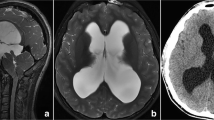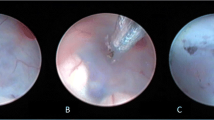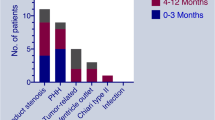Abstract
Background
Preoperative judgment who will benefit from endoscopic third ventriculostomy (ETV) in infantile hydrocephalus remains controversial and no sufficient clue exists. Although ETV success score (ETVSS) is a useful scale in predicting ETV success in hydrocephalus, its efficacy in infants younger than 1 year old has been limited. This study aimed to verify the efficacy of a newly defined sign, “third ventricle floor bowing (TVFB),” in predicting ETV success in infantile hydrocephalus for the first time and discuss the mechanism of this sign and its clinical meanings.
Methods
Between January 2013 and April 2018, hydrocephalic infants (age ≤ 12 months) with third ventricle floor bowing were treated endoscopically in the Department of Neurosurgery, West China Hospital. The medical records of these patients were reviewed. Additionally, we undertook a detailed review of the reported data on the treatment of infantile hydrocephalus with endoscopic third ventriculostomy (ETV).
Results
A total of 42 infants underwent ETV alone in our institution, with a median age of 7.3 ± 3.8 months. Common etiologies included postinfectious (26.2%), arachnoid cyst (14.3%), aqueductal stenosis (11.9%), and congenital condition (11.9%). The complications included seizure (2.4%), CSF leak (2.4%), and subdural effusion (2.4%). During the average follow-up of 21.7 ± 13.1 months, the ETV success rate predicted by third ventricle floor bowing (TVFB) was 71.4%, which was higher than 6-month success rate predicted by the ETVSS (52.3%). However, it was difficult to reach statistical significance (P = 0.072) due to the limited sample size and further studies with larger sample size were needed.
Conclusions
Our study suggests TVFB can serve as a useful method for selecting ETV candidates in infantile hydrocephalus preoperatively. And we speculate that good ventricle compliance and pressure difference between the ventricle and subarachnoid space are essential elements in ensuring ETV success.


Similar content being viewed by others
References
Balthasar AJ, Kort H, Cornips EM, Beuls EA, Weber JW, Vles JS (2007) Analysis of the success and failure of endoscopic third ventriculostomy in infants less than 1 year of age. Child’s nervous system : ChNS : official journal of the International Society for Pediatric Neurosurgery 23:151–155. https://doi.org/10.1007/s00381-006-0219-z
Buxton N, Macarthur D, Mallucci C, Punt J, Vloeberghs M (1998) Neuroendoscopic third ventriculostomy in patients less than 1 year old. Pediatr Neurosurg 29:73–76. https://doi.org/10.1159/000028693
Costa Val JA, Scaldaferri PM, Furtado LM, de Souza BG (2012) Third ventriculostomy in infants younger than 1 year old. Child’s nervous system : ChNS : official journal of the International Society for Pediatric Neurosurgery 28:1233–1235. https://doi.org/10.1007/s00381-012-1740-x
Dlouhy BJ, Capuano AW, Madhavan K, Torner JC, Greenlee JD (2012) Preoperative third ventricular bowing as a predictor of endoscopic third ventriculostomy success. J Neurosurg Pediatr 9:182–190. https://doi.org/10.3171/2011.11.peds11495
Elgamal EA, El-Dawlatly AA, Murshid WR, El-Watidy SM, Jamjoom ZA (2011) Endoscopic third ventriculostomy for hydrocephalus in children younger than 1 year of age. Child’s nervous system : ChNS : official journal of the International Society for Pediatric Neurosurgery 27:111–116. https://doi.org/10.1007/s00381-010-1254-3
Faggin R, Bernardo A, Stieg P, Perilongo G, d’Avella D (2009) Hydrocephalus in infants less than six months of age: effectiveness of endoscopic third ventriculostomy. European journal of pediatric surgery : official journal of Austrian Association of Pediatric Surgery [et al] = Zeitschrift fur Kinderchirurgie 19:216–219. https://doi.org/10.1055/s-0029-1202282
Fani L, de Jong TH, Dammers R, van Veelen ML (2013) Endoscopic third ventriculocisternostomy in hydrocephalic children under 2 years of age: appropriate or not? A single-center retrospective cohort study. Child’s nervous system : ChNS : official journal of the International Society for Pediatric Neurosurgery 29:419–423. https://doi.org/10.1007/s00381-012-1961-z
Foroughi M, Wong A, Steinbok P, Singhal A, Sargent MA, Cochrane DD (2011) Third ventricular shape: a predictor of endoscopic third ventriculostomy success in pediatric patients. J Neurosurg Pediatr 7:389–396. https://doi.org/10.3171/2011.1.peds10461
Fritsch MJ, Kienke S, Ankermann T, Padoin M, Mehdorn HM (2005) Endoscopic third ventriculostomy in infants. J Neurosurg 103:50–53. https://doi.org/10.3171/ped.2005.103.1.0050
Fritsch MJ, Mehdorn M (2002) Endoscopic intraventricular surgery for treatment of hydrocephalus and loculated CSF space in children less than one year of age. Pediatr Neurosurg 36:183–188. https://doi.org/10.1159/000056055
Garcia LG, Lopez BR, Botella GI, Paez MD, da Rosa SP, Rius F, Sanchez MA (2012) Endoscopic Third Ventriculostomy Success Score (ETVSS) predicting success in a series of 50 pediatric patients. Are the outcomes of our patients predictable? Child's nervous system : ChNS : official journal of the International Society for Pediatric Neurosurgery 28:1157–1162. https://doi.org/10.1007/s00381-012-1836-3
Gianaris TJ, Nazar R, Middlebrook E, Gonda DD, Jea A, Fulkerson DH (2017) Failure of ETV in patients with the highest ETV success scores. J Neurosurg Pediatr 20:225–231. https://doi.org/10.3171/2016.7.peds1655
Gorayeb RP, Cavalheiro S, Zymberg ST (2004) Endoscopic third ventriculostomy in children younger than 1 year of age. J Neurosurg 100:427–429. https://doi.org/10.3171/ped.2004.100.5.0427
He Z, An C, Zhang X, He X, Li Q (2015) The efficacy analysis of endoscopic third ventriculostomy in infantile hydrocephalus. J Korean Neurosurg Soc 57:119–122. https://doi.org/10.3340/jkns.2015.57.2.119
Hopf NJ, Grunert P, Fries G, Resch KD, Perneczky A (1999) Endoscopic third ventriculostomy: outcome analysis of 100 consecutive procedures. Neurosurgery 44:795–804 discussion 804-796
Javadpour M, Mallucci C, Brodbelt A, Golash A, May P (2001) The impact of endoscopic third ventriculostomy on the management of newly diagnosed hydrocephalus in infants. Pediatr Neurosurg 35:131–135. https://doi.org/10.1159/000050406
Jernigan SC, Berry JG, Graham DA, Goumnerova L (2014) The comparative effectiveness of ventricular shunt placement versus endoscopic third ventriculostomy for initial treatment of hydrocephalus in infants. J Neurosurg Pediatr 13:295–300. https://doi.org/10.3171/2013.11.peds13138
Kehler U, Regelsberger J, Gliemroth J, Westphal M (2006) Outcome prediction of third ventriculostomy: a proposed hydrocephalus grading system. Minimally invasive neurosurgery : MIN 49:238–243. https://doi.org/10.1055/s-2006-950382
Koch D, Wagner W (2004) Endoscopic third ventriculostomy in infants of less than 1 year of age: which factors influence the outcome? Child’s nervous system : ChNS : official journal of the International Society for Pediatric Neurosurgery 20:405–411. https://doi.org/10.1007/s00381-004-0958-7
Koch-Wiewrodt D, Wagner W (2006) Success and failure of endoscopic third ventriculostomy in young infants: are there different age distributions? Child’s nervous system : ChNS : official journal of the International Society for Pediatric Neurosurgery 22:1537–1541. https://doi.org/10.1007/s00381-006-0191-7
Kulkarni AV, Drake JM, Kestle JR, Mallucci CL, Sgouros S, Constantini S, Canadian Pediatric Neurosurgery Study G (2010) Predicting who will benefit from endoscopic third ventriculostomy compared with shunt insertion in childhood hydrocephalus using the ETV Success Score. J Neurosurg Pediatr 6:310–315. https://doi.org/10.3171/2010.8.PEDS103
Kulkarni AV, Drake JM, Mallucci CL, Sgouros S, Roth J, Constantini S (2009) Endoscopic third ventriculostomy in the treatment of childhood hydrocephalus. J Pediatr 155:254–259.e251. https://doi.org/10.1016/j.jpeds.2009.02.048
Kulkarni AV, Riva-Cambrin J, Browd SR, Drake JM, Holubkov R, Kestle JR, Limbrick DD, Rozzelle CJ, Simon TD, Tamber MS, Wellons JC 3rd, Whitehead WE, Hydrocephalus Clinical Research N (2014) Endoscopic third ventriculostomy and choroid plexus cauterization in infants with hydrocephalus: a retrospective Hydrocephalus Clinical Research Network study. J Neurosurg Pediatr 14:224–229. https://doi.org/10.3171/2014.6.PEDS13492
Kulkarni AV, Sgouros S, Constantini S, Investigators I (2016) International Infant Hydrocephalus Study: initial results of a prospective, multicenter comparison of endoscopic third ventriculostomy (ETV) and shunt for infant hydrocephalus. Child’s nervous system : ChNS : official journal of the International Society for Pediatric Neurosurgery 32:1039–1048. https://doi.org/10.1007/s00381-016-3095-1
Lipina R, Reguli S, Dolezilova V, Kuncikova M, Podesvova H (2008) Endoscopic third ventriculostomy for obstructive hydrocephalus in children younger than 6 months of age: is it a first-choice method? Child’s nervous system : ChNS : official journal of the International Society for Pediatric Neurosurgery 24:1021–1027. https://doi.org/10.1007/s00381-008-0616-6
Madsen PJ, Mallela AN, Hudgins ED, Storm PB, Heuer GG, Stein SC (2018) The effect and evolution of patient selection on outcomes in endoscopic third ventriculostomy for hydrocephalus: a large-scale review of the literature. J Neurol Sci 385:185–191. https://doi.org/10.1016/j.jns.2017.12.025
Ogiwara H, Dipatri AJ Jr, Alden TD, Bowman RM, Tomita T (2010) Endoscopic third ventriculostomy for obstructive hydrocephalus in children younger than 6 months of age. Child’s nervous system : ChNS : official journal of the International Society for Pediatric Neurosurgery 26:343–347. https://doi.org/10.1007/s00381-009-1019-z
Stone SS, Warf BC (2014) Combined endoscopic third ventriculostomy and choroid plexus cauterization as primary treatment for infant hydrocephalus: a prospective North American series. J Neurosurg Pediatr 14:439–446. https://doi.org/10.3171/2014.7.peds14152
Sufianov AA, Sufianova GZ, Iakimov IA (2010) Endoscopic third ventriculostomy in patients younger than 2 years: outcome analysis of 41 hydrocephalus cases. J Neurosurg Pediatr 5:392–401. https://doi.org/10.3171/2009.11.PEDS09197
Wang Q, Hui X, Li Q, Ju Y (2018) Letter to the Editor. Preoperative third ventricle shape and ETV Journal of neurosurgery Pediatrics 21:542–543. https://doi.org/10.3171/2017.10.PEDS17534
Warf BC (2005) Comparison of endoscopic third ventriculostomy alone and combined with choroid plexus cauterization in infants younger than 1 year of age: a prospective study in 550 African children. J Neurosurg 103:475–481. https://doi.org/10.3171/ped.2005.103.6.0475
Warf BC, Tracy S, Mugamba J (2012) Long-term outcome for endoscopic third ventriculostomy alone or in combination with choroid plexus cauterization for congenital aqueductal stenosis in African infants. J Neurosurg Pediatr 10:108–111. https://doi.org/10.3171/2012.4.PEDS1253
Zohdi AZ, El Damaty AM, Aly KB, El Refaee EA (2013) Success rate of endoscopic third ventriculostomy in infants below six months of age with congenital obstructive hydrocephalus (a preliminary study of eight cases). Asian journal of neurosurgery 8:147–152. https://doi.org/10.4103/1793-5482.121686
Zucchelli M, Galassi E (2018) Higher failure of endoscopic third ventriculostomy in infants: the “distensible” skull is the culprit. Pediatr Neurosurg 53:163–166. https://doi.org/10.1159/000487090
Funding
Sichuan Department of Science and Technology provided financial support in the form of Sichuan Science and Technology Support Program (No. 2018SZ0043).
Author information
Authors and Affiliations
Corresponding author
Ethics declarations
Ethical approval
All procedures performed in studies involving human participants were in accordance with the ethical standards of the institutional and/or national research committee (ethics committee of West China Hospital) and with the 1964 Helsinki declaration and its later amendments or comparable ethical standards. For this type of study, formal consent is not required.
Conflict of interest
The authors declare that they have no conflict of interest.
Informed consent
Informed consent was obtained from all individual participants included in the study.
Additional information
Publisher’s note
Springer Nature remains neutral with regard to jurisdictional claims in published maps and institutional affiliations.
The contents of the paper have not been presented or published previously.
This article is part of the Topical Collection on Pediatric Neurosurgery
Rights and permissions
About this article
Cite this article
Wang, Q., Cheng, J., Si, Z. et al. Third ventricle floor bowing: a useful measurement to predict endoscopic third ventriculostomy success in infantile hydrocephalus. Acta Neurochir 162, 31–37 (2020). https://doi.org/10.1007/s00701-019-04133-7
Received:
Accepted:
Published:
Issue Date:
DOI: https://doi.org/10.1007/s00701-019-04133-7




